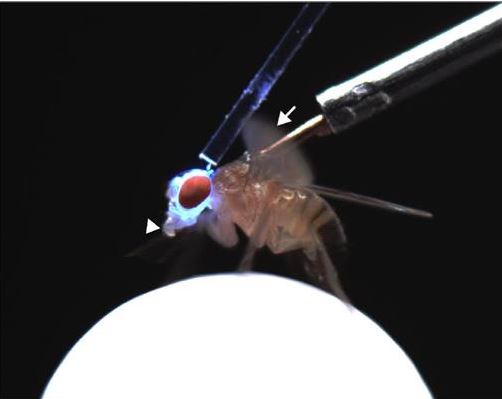The neurons that express the fruitless (fru) gene "basically govern the whole aspect of male sexual behavior," explains Tohoku University neurogenetics professor Daisuke Yamamoto. Normal male fruit flies tap the abdomen of a female to get a whiff of her sex pheromones before pursuing her to mate. In contrast, males with a mutant version of the fru gene show no interest in females; instead, they set off in vigorous pursuit of other males.
In the new study, Yamamoto wanted to analyze the role of vision in the courtship behavior of normal and mutant fruit flies. He optically stimulated neurons in a region of the fruit fly brain known to control courtship decision-making. The fruit flies were shown spots of white light flashing across a screen that represented walking females. Normal fruit flies courted the spots only after priming with pheromones, but mutant males did not need pheromone priming or direct brain stimulation. The mutant fruit flies immediately followed the moving light spots and vibrated their wings in courtship.

The optical stimulation of neurons in a region of the fruit fly brain are known to control courtship decision-making.
However, this behavior was only displayed in mutant males reared in groups. "We found that this kind of visually induced courtship behavior in the fru mutant males was blocked by isolating them right after their emergence from the pupa," says Yamamoto. The males reared by themselves did not react to the light spots, he says.
Yamamoto says he had previously never doubted that male-to-male courtship in fru mutant males was "solely genetically programmed". It appears that social interaction activates neurons that make mutant males hypersensitive to visual stimuli. He believes some aspects of sexual orientation in humans could have a similar mechanistic basis to that of flies. "Our study offers a conceptual basis to explain how nature and nurture interact in shaping human sexual orientation," he says.
Citation: Kohatsu, S.&Yamamoto, D., Visually induced initiation of Drosophila innate courtship-like following pursuit is mediated by central excitatory state, Nature Communications 6, 6457 (2015). DOI: 10.1038/ncomms7457





Comments